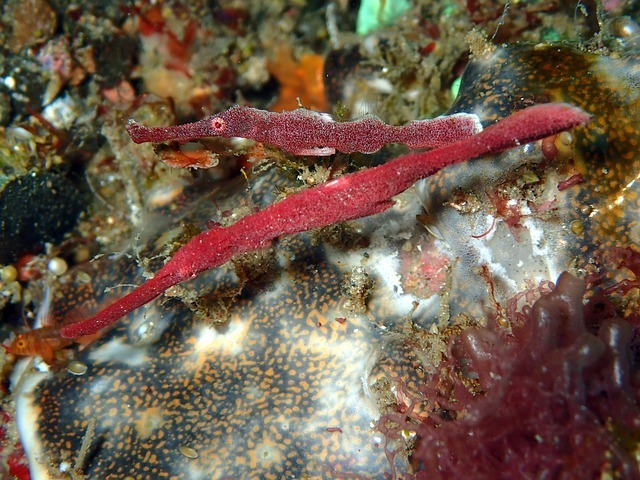Seahorses are interesting, adorable creatures, from their coiling tails to their horse-like heads.
It’s tempting to add one to your aquarium, but what if you have a freshwater tank? Can you put a seahorse in it, or do you need a saltwater tank?
A quick Google search tells you that seahorses are saltwater fish, but also shows you articles about the quest for a “mythical” freshwater seahorse in the Mekong or Titikaka.
A trip to the local pet store reveals tanks labeled “freshwater seahorse,” with a creature inside that looks more like a little snake than the typical seahorse.
This might lead you to wonder: are there proper freshwater seahorses?
Contents
Technically, No – a Freshwater Seahorse is a Pipefish
Despite the rumors, and the stories about freshwater species having long since gone extinct, the only remaining seahorses on Earth are marine fish – “marine” here referring to the sea, which is a saltwater body.
Occasionally, a pet store may advertise a “freshwater aquarium seahorse,” but these fish are technically not seahorses. They are a different creature altogether – called a pipefish.
Pipefish is a close relative of seahorses, and do look very similar to their cousins. The difference in their appearance is that they appear less as a horse and more like a long, straight-bodied snake.
They get their “pipe” name from the tube-like shape of their snout, which ends in a narrow, toothless mouth.
The pipefish tail is much longer than the typical seahorse’s tail, and they come in many color variations, such as the Blue Striped Pipefish, the Red Stripe Pipefish, the Tiger Pipefish, and the Orange Spotted Pipefish.
So if you already have a freshwater tank and want to add a fish that is similar to a seahorse, you might want to consider this variety!
If you are dead-set on owning a seahorse, however, you will need a few more steps to prepare.

How to Care for a Freshwater Seahorse
Here are some steps to keep in mind when buying a seahorse.
Do Your Research
Before you take any other steps toward getting a seahorse, do some research, either online or at the library.
There are many different species of seahorse, and each have different needs for their diet and environment.
Additionally, there are different sizes, though most will range between five to eight inches in length, and they must eat more than other fish to maintain their energy levels.
Look into what kind of water temperature the seahorse you’re interested in needs, and what the signs are of injury or illness, so you’ll be prepared to respond to any negative circumstances.
Additionally, do some research about saltwater tanks, which can require more maintenance than your typical freshwater aquarium.
Research can seem daunting, but it’s an important first step. The more you learn, the better able you’ll be to take good care of your seahorse!
Get a New Saltwater Tank
Seahorses do best in a new tank, so if you can avoid introducing them to your established aquarium, that would be best.
When investing in a saltwater aquarium, remember that seahorses are vertically-oriented animals, requiring a taller tank than a horizontal fish might need!
They also prefer cooler water than most tropical aquarium fish do, so you may need a tank with a fan or chiller.
Furnish the tank with hitching posts and plants for your seahorse to latch onto, as this environment is more conducive to their health – and to your aesthetics!
Get Some Tankmates
Your seahorse doesn’t have to live alone! After your new fish is used to the hangout, feel free to add tankmates.
Stick to slow-moving fish, like royal grammas and scooter blennies, as these slower, more cautious fish will coexist well with the seahorse, which has a lower activity level.
More energetic fish are acceptable, but may cause unnecessary stress in your little ‘herd.’ You can also add small, seahorse-friendly corals, like green star polyps, for some added variety.
Invertebrates like snails or small hermit crabs may also prove good roommates for your seahorse – but stay away from any big crabs that might try to snip at your seahorse’s tail!
Decide How to Feed Them
When it comes to feeding your seahorse, you have two options: hand-feeding or setting up a feeding station!
Aquarium seahorses eat shrimp, and they are slow, methodical eaters. If you hand-feed them, you’ll need to be a little patient, as they take their time to enjoy the meal.
A feeding station may be more convenient for you, if you have a high-speed life or aren’t always home to feed them personally. All you need is a cuplike object that the seahorse can come up to, like a clear glass bowl, with some hitching posts that the seahorses can latch onto.
Now that you’ve taken the time to consider your options – for both seahorses and their freshwater counterpart, the pipefish – you’re ready to add a new fishy friend to your life!




Look up the largest lake in south America. Lake tittikakka its not spelled like that but I suck at spelling. It has fresh water seahorses. Was a big deal made the news.